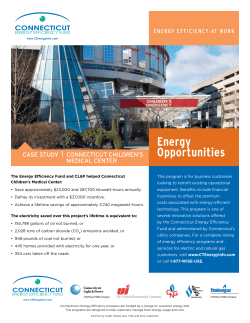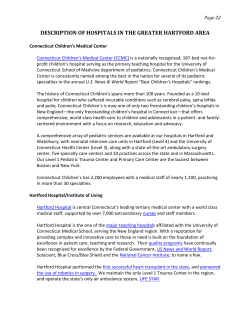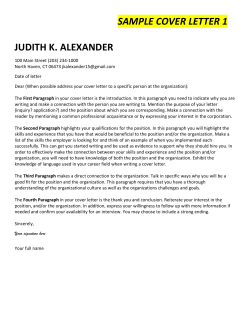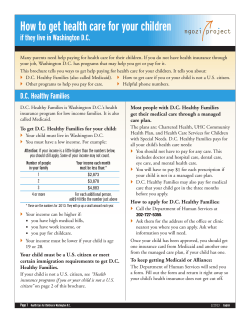
Document 243742
Issue Brief June 2014 Patient-Centered Medical Homes in Connecticut: Why national standards matter Patient-‐centered medical homes (PCMHs) are sweeping Connecticut and the country providing impressive results – improving access to high quality care, improving patient and provider satisfaction, and controlling costs. Patient-‐centered medical homes are a relatively new model of providing primary, preventive care where people are given the tools they need to direct their own care and keep themselves healthy. When a person has a medical problem, they don’t have to figure out who to call, they call their medical home. Their PCMH follows up on their needs, not just suggesting referrals for specialty care but making appointments and following up on treatment plans. PCMHs remind patients when it’s time for preventive care and screens. Access to care in a PCMH is available beyond usual business hours and the same day the patient calls for urgent problems. PCMH care is delivered by a team of providers with different skills and strengths all working together with the patient on realistic care plans to make people healthy. As one PCMH nurse manager put it, “all the care swirls around the patient, not the other way around.” Certified PCMHs are reimbursed for this higher level of care in various ways in different plans and programs. There are several national accrediting bodies that certify patient centered medical homes but four out of five are certified by NCQA – the National Committee on Quality Assurance – the gold standard in PCMH recognition. Growing evidence finds that certified PCMHs build value by improving the quality of care and controlling costs A recent literature review found that PCMHs • reduce the total cost of care • reduce the use of unnecessary and avoidable services • improve population health metrics • increase the use of preventive services • improve access to care, and • improve patient satisfaction. The longer a practice has had PCMH status, the greater the cost savings and the better the improvements in care quality and outcomes.i There is strong evidence that providers are more satisfied practicing in a PCMH including better work hours and more time with www.cthealthpolicy.org patients. That enhanced provider satisfaction in PCMHs is stabilizing primary care practice and expanding badly needed primary care capacity.ii Connecticut’s Medicaid program is improving significantly from PCMHs, just in time for expanded membership Shifting Connecticut’s Medicaid program to PCMHs over the last two years has resulted in greatly improved quality of care, 32% more participating providers, and a 2% reduction in per person costs of care. There are now almost 250,000 Medicaid members being served by 1,193 PCMH providers; those numbers grow every month.iii This Medicaid improvement is just in time to meet sharply rising demands from expanded enrollment in the program. Connecticut’s Medicaid program has a history of difficulty in meeting the health care needs of the people who depend on the program. A large part of that difficulty was a lack of participating providers. PCMHs hold great promise in engaging new primary care providers in the program. With eligibility expansions under the Affordable Care Act, Medicaid is expected to cover one in five state residents.iv Care delivered in Connecticut Medicaid PCMH practices exceeds the quality of care delivered by non-‐PCMH practices across metrics. Children being seen in PCMH practices are over 10% more likely to receive recommended EPSDT screenings. Quality metrics earned in PCMHs are better than non-‐PCMH practices for: • • • • • • • Adolescent well-‐care visits Well child visits < 16 months age Well child visits 3,4,5, and 6 year olds Adult access to primary care Annual dental visit Eye exams for people with diabetes LDL screens for people with diabetesv Connecticut’s medical practices are also benefitting from Medicaid’s shift to PCMHs. In 2012 the average PCMH Medicaid practice received $150,000 in higher reimbursements; glide path practices pursuing PCMH certification averaged $33,824 in higher reimbursements.vi Community Health Network, (CHN) the state’s Medicaid administrator, reports that virtually all practices that enter the glide path and make a commitment to patient-‐centered care are successful and achieve PCMH recognition. CHN reports no complaints about the PCMH standards being too difficult or not worth the effort. The only complaints they’ve received are about the costs of certification, $2,280 for a Connecticut practice with five cliniciansvii, and time commitments necessary to transform to a patient-‐centered model. CHN audits Connecticut Medicaid PCMHs annually to ensure they are maintaining quality standards.viii A very recent study found that electronic medical records or large practice sizes are not necessary for PCMH status and the resulting quality gains.ix www.cthealthpolicy.org National standards to recognize PCMHs ensure quality Nationally consistent recognition standards allow apples-‐to-‐apples comparisons with other states, allowing Connecticut to benefit from research and best practices developed elsewhere. While there are several national PCMH recognition authorities, NCQA has become the prevalent PCMH recognition standard. Four out of five PCMHs in the US are recognized by NCQA.x NCQA standards evolve with the changing health care landscape, updating every 3 years to accommodate best practices and knowledge from the growing PCMH literature. NCQA has spent close to $10 million and eight years developing PCMH standards based on research and experience across all fifty states. NCQA dedicates 35 full-‐time employees to PCMH recognition activities.xi While it is a meaningful standard, NCQA recognition is achievable for every Connecticut primary care practice. There are 1,047 NCQA recognized PCMHs and providers in Connecticut and the number is growing.xii NCQA has made multiple changes over the years to significantly reduce the administration burden on providers – the goal is to make recognition a byproduct of practice transformation.xiii NCQA reports that in the first five months of this year, orders from Connecticut practices for PCMH recognition packages are up significantly from 2013.xiv Connecticut should continue to utilize national standards for PCMHs rather than build our own Proposals have surfaced to reject national PCMH standards like NCQA and for Connecticut policymakers to develop a state-‐specific recognition process. The idea has been raised for both Medicaid and for the entire state health system in State Innovation Model planning.xv This would be unwise and erode Connecticut’s hard-‐won progress toward reform for several reasons. • State specific standards would be subject to political winds – Any Connecticut-‐ specific PCMH standards could be weakened by future changes in administration. NCQA standards are only subject to best practices and research, not who is elected to political office in Connecticut. • National PCMH standards are meaningful – NCQA recognition is associated with improved health outcomes and cost control. Rewarding higher quality is the essence of value-‐based purchasing and fixing our broken health care system. • Don’t fix what isn’t broken – NCQA and other national PCMH standards are familiar to Connecticut providers and payers, and are working to reward better value. • National PCMH standards are reasonable – A large and growing number of Connecticut practices are NCQA recognized and more are achieving the goal every month. • The cost to Connecticut of developing our own standards in delayed quality improvement and cost control would be significant. Connecticut now benefits www.cthealthpolicy.org • from NCQA’s significant investment, expertise and knowledge of PCMH best practices. There are better uses for resources -‐-‐ Re-‐creating effective PCMH standards could cost Connecticut $10 million and take eight years, as it did NCQA. And it is not a one-‐time process, but standards must be evaluated and adjusted constantly. Connecticut could use those resources for many better purposes such as annual audits of all PCMHs (not just Medicaid as is now done by CHN), patient self-‐management and decision support tools, resources for practices struggling to transform, learning collaboratives for current PCMHs to build on successes, and research on best practices. i The Patient-‐Centered Medical Home’s Impact on Cost and Quality, January 2014, Milbank Memorial Fund ii C Sinsky et. al., In Search of Joy in Practice: A Report of 23 High-‐Performing Primary Care Practices, Annals of Internal Medicine 11:272-‐278, 2013 iii DSS presentation to Care Management MAPOC Committee, May 21, 2014 iv Connecticut Health Reform by the Numbers, CT Health Policy Project, August 2012 v DSS presentation to MAPOC, Jan. 10, 2014 vi ibid vii NCQA PCMH and PCSP Recognition Program Pricing, accessed June 4, 2014 viii DSS presentation to Care Management MAPOC Committee, May 21, 2014 ix L Kern, et. al., The Patient-‐Centered Medical Home, Electronic Health Records, and Quality of Care, Ann Int Med 160:741-‐749, 2014 x J Nwando Olayiwola, co-‐author The Patient-‐Centered Medical Home’s Impact on Cost and Quality, January 2014, Milbank Memorial Fund, remarks at Weitzman Institute Annual Conference, 5/15/14, Middletown CT xi NCQA PCMH recognition, CT Health Policy Project webinar, 5/29/14 xii NCQA Recognition Directory, accessed May 25, 2014 xiii NCQA PCMH recognition, CT Health Policy Project webinar, May 29, 2014 xiv Personal communication, NCQA, May 31, 2014 xv Care Management MAPOC Committee meeting, May 21, 2014; Connecticut SIM final plan, December 2013 www.cthealthpolicy.org
© Copyright 2025

















